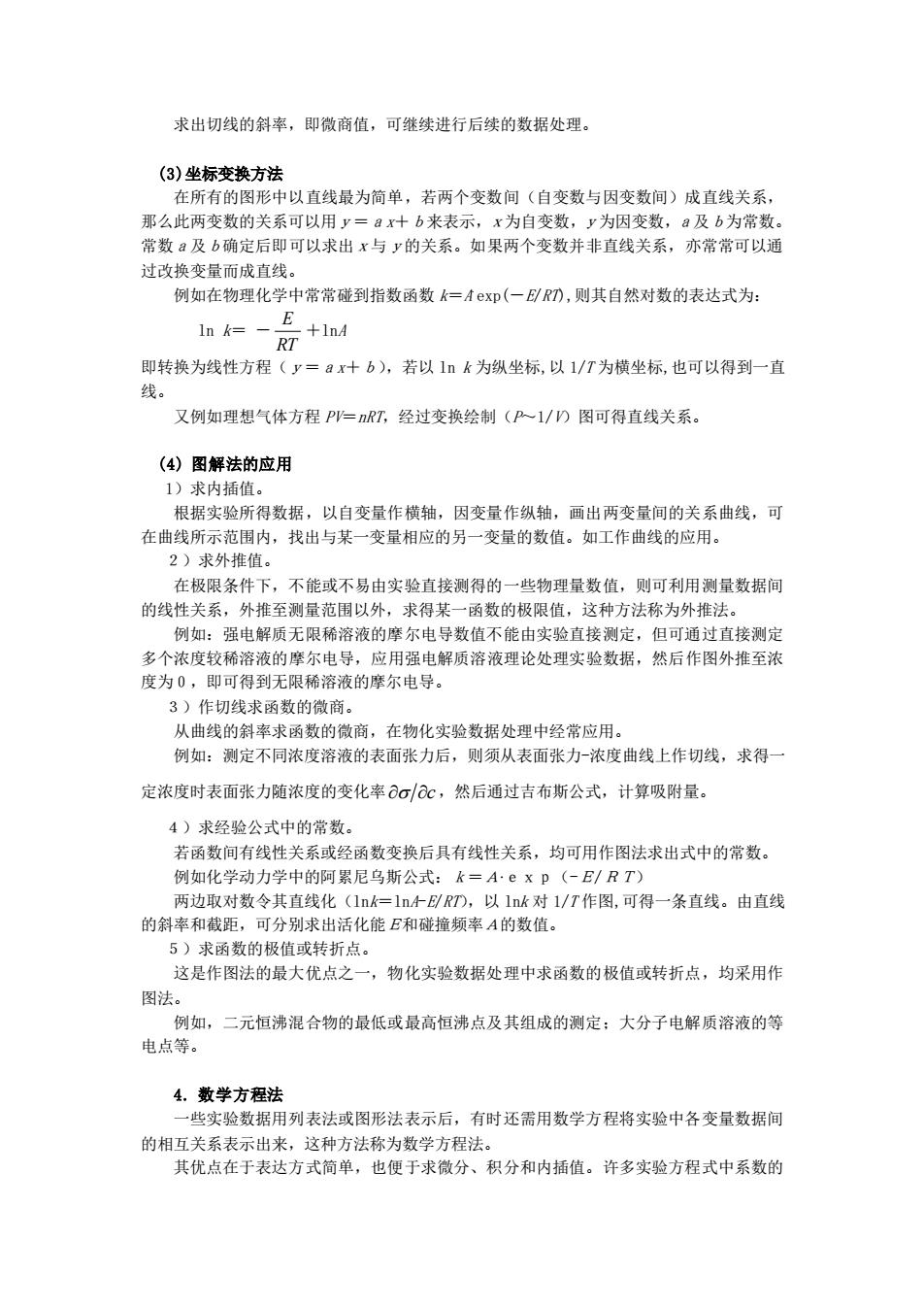
求出切线的斜率,即微商值,可继续进行后续的数据处理 (3)坐标变换方法 在所有的图形中以直线最为简单,若两个变数间(自变数与因变数间)成直线关系, 那么此两变数的关系可以用y=ax十b来表示,x为自变数,y为因变数,a及b为常数。 常数a及b确定后即可以求出x与y的关系。如果两个变数并非直线关系,亦常常可以通 过改换变量而成直线。 例如在物理化学中常常碰到指数函数仁Axp(一,则其自然对数的表达式为: 1nk=- 衍+1n 即转换为线性方程(y=ax十b),若以1k为纵坐标,以1/T为横坐标,也可以得到一直 线。 又例如理想气体方程P=RT,经过变换绘制(P-1/)图可得直线关系 (4)图解法的应用 1)求内插值。 根据实验所得数据,以自变量作横轴,因变量作级轴,画出两变量间的关系曲线,可 在曲线所示范围内,找出与某一变量相应的另一变量的数值。如工作曲线的应用。 2)求外推值 在极限条件下,不能或不易由实验直接测得的一些物理量数值,则可利用测量数据间 的线性关系,外推至测量范围以外,求得某一函数的极限值,这种方法称为外推法。 例如:强电解质无限稀溶液的摩尔电导数值不能由实验直接测定,但可通过直接测定 多个浓度较稀溶液的摩尔电导,应用强电解质溶液理论处理实验数据,然后作图外推至浓 度为0,即可得到无限稀 等液的摩尔电导 3)作切线求函数的微商。 从曲线的斜率求函数的微商,在物化实验数据处理中经常应用。 例如:测定不同浓度溶液的表面张力后,则须从表面张力-浓度曲线上作切线,求得 定浓度时表面张力随浓度的变化率/c,然后通过吉布斯公式,计算吸附量。 4)求经验公式中的常数。 若函数间有线性关系或经函数变换后具有线性关系,均可用作图法求出式中的常数。 例如化学动力学中的阿累尼乌斯公式:素=A:exp(-E/RT) 两边取对数令其直线化(1nk=1nk列R刀,以1nk对1/T作图.可得一条直线。由直线 的斜率和藏距,可分别求出活化能E和碰撞频率A的数值。 5)求函数的极值或转 「点 这是作图法的最大优点之一,物化实验数据处理中求函数的极值或转折点,均采用作 图法。 例如,二元恒沸混合物的最低或最高恒沸点及其组成的测定:大分子电解质溶液的等 电点等 4.数学方程法 一些实验数据用列表法或图形法表示后,有时还需用数学方程将实验中各变量数据间 的相互关系表示出来,这种方法称为数学方程法。 其优点在于表达方式简单,也便于求微分、积分和内插值。许多实验方程式中系数的
求出切线的斜率,即微商值,可继续进行后续的数据处理。 (3)坐标变换方法 在所有的图形中以直线最为简单,若两个变数间(自变数与因变数间)成直线关系, 那么此两变数的关系可以用y=ax+b来表示,x为自变数,y为因变数,a及b为常数。 常数a及b确定后即可以求出x与y的关系。如果两个变数并非直线关系,亦常常可以通 过改换变量而成直线。 例如在物理化学中常常碰到指数函数 k=A . exp(-E/RT),则其自然对数的表达式为: ln k= - RT E +lnA 即转换为线性方程(y=ax+b),若以 ln k 为纵坐标,以 1/T 为横坐标,也可以得到一直 线。 又例如理想气体方程 PV=nRT,经过变换绘制(P~1/V)图可得直线关系。 (4) 图解法的应用 1)求内插值。 根据实验所得数据,以自变量作横轴,因变量作纵轴,画出两变量间的关系曲线,可 在曲线所示范围内,找出与某一变量相应的另一变量的数值。如工作曲线的应用。 2)求外推值。 在极限条件下,不能或不易由实验直接测得的一些物理量数值,则可利用测量数据间 的线性关系,外推至测量范围以外,求得某一函数的极限值,这种方法称为外推法。 例如:强电解质无限稀溶液的摩尔电导数值不能由实验直接测定,但可通过直接测定 多个浓度较稀溶液的摩尔电导,应用强电解质溶液理论处理实验数据,然后作图外推至浓 度为0,即可得到无限稀溶液的摩尔电导。 3)作切线求函数的微商。 从曲线的斜率求函数的微商,在物化实验数据处理中经常应用。 例如:测定不同浓度溶液的表面张力后,则须从表面张力-浓度曲线上作切线,求得一 定浓度时表面张力随浓度的变化率 c ,然后通过吉布斯公式,计算吸附量。 4)求经验公式中的常数。 若函数间有线性关系或经函数变换后具有线性关系,均可用作图法求出式中的常数。 例如化学动力学中的阿累尼乌斯公式:k=A∙exp(-E/RT) 两边取对数令其直线化(lnk=lnA-E/RT),以 lnk 对 1/T 作图,可得一条直线。由直线 的斜率和截距,可分别求出活化能E和碰撞频率A的数值。 5)求函数的极值或转折点。 这是作图法的最大优点之一,物化实验数据处理中求函数的极值或转折点,均采用作 图法。 例如,二元恒沸混合物的最低或最高恒沸点及其组成的测定;大分子电解质溶液的等 电点等。 4. 数学方程法 一些实验数据用列表法或图形法表示后,有时还需用数学方程将实验中各变量数据间 的相互关系表示出来,这种方法称为数学方程法。 其优点在于表达方式简单,也便于求微分、积分和内插值。许多实验方程式中系数的
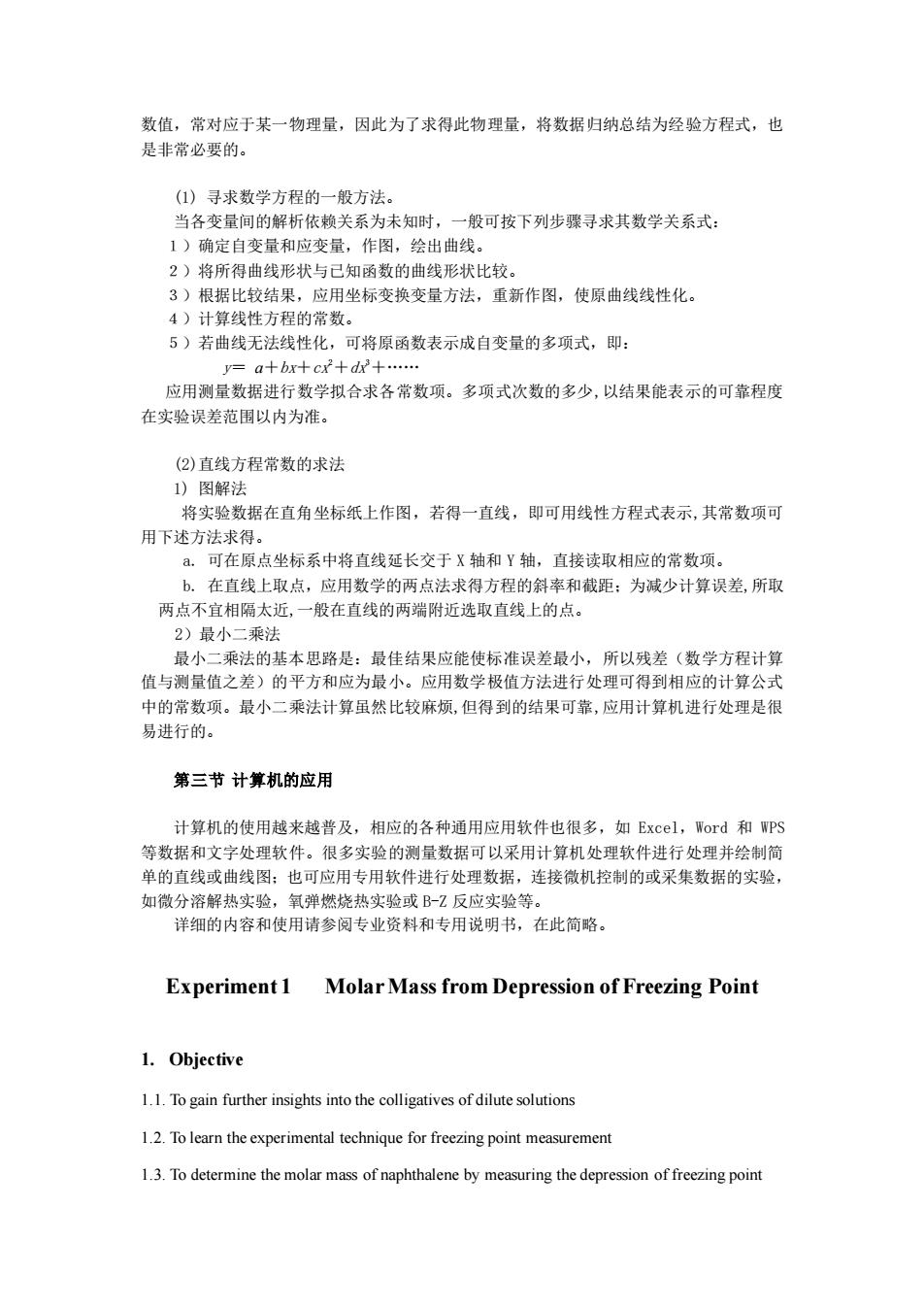
数值,常对应于某一物理量,因此为了求得此物理量,将数据归纳总结为经验方程式,也 是非常必要的。 ()寻求数学方程的一般方法。 当各变量间的解析依赖关系为未知时,一般可按下列步骤寻求其数学关系式: 1)确定自变量和应变量,作图,绘出曲线。 2)将所得曲线形状与已知函数的曲线形状比较。 3)根据比较结果,应用坐标变换变量方法, 重新作图,使原曲线线性化 4)计算线性 万性的帘数。 5)若曲线无法线性化,可将原函数表示成自变量的多项式,即: =a+br+c2+d3+. 应用测量数据进行数学拟合求各常数项。多项式次数的多少,以结果能表示的可靠程度 在实验误差范围以内为准。 (②)直线方程常数的求法 1)图解法 将实验数据在直角坐标纸上作图,若得一直线,即可用线性方程式表示,其常数项可 用下述方法求得。 可在原点坐标系中将直线延长交于X轴和Y轴。直接读取相应的常数项。 山。在直线上取点,应用数学的两点法求得方程的斜率和截距:为减少计算误差,所取 两点不宜相隔太近,一般在直线的两端附近选取直线上的点。 2)最小二乘法 最小二乘法的基本思路是:最佳结果应能使标准误差最小,所以残差(数学方程计算 值与测量值之差)的平方和应为最小。应用数学极值方法进行处理可得到相应的计算公式 中的常数项。最小二乘法计算虽然比较麻烦,但得到的结果可靠,应用计算机进行处理是 易进行的。 第三节计算机的应用 计算机的使用越米越普及,相应的各种通用应用软件也很多,如Excel,Word和P 等数据和文字处理软件。很多实验的测量数据可以采用计算机处理软件进行处理并绘制简 单的直线或曲线图:也可应用专用软件进行处理数据,连接微机控制的或采集数据的实验, 如微分溶解热实验,氧弹燃烧热实验或B-2反应实验等。 详细的内容和使用请参阅专业资料和专用说明书,在此简略。 Experiment 1 Molar Mass from Depression of Freezing Point 1.Objective 1.1.To gain further insights into the colligatives of dilute solutions 1.2.To learn the experimental technique for freezing point measuremen 1.3.To determine the molar mass of naphthalene by measuring the depression of freezing point
数值,常对应于某一物理量,因此为了求得此物理量,将数据归纳总结为经验方程式,也 是非常必要的。 (1) 寻求数学方程的一般方法。 当各变量间的解析依赖关系为未知时,一般可按下列步骤寻求其数学关系式: 1)确定自变量和应变量,作图,绘出曲线。 2)将所得曲线形状与已知函数的曲线形状比较。 3)根据比较结果,应用坐标变换变量方法,重新作图,使原曲线线性化。 4)计算线性方程的常数。 5)若曲线无法线性化,可将原函数表示成自变量的多项式,即: y= a+bx+cx 2+dx 3+. 应用测量数据进行数学拟合求各常数项。多项式次数的多少,以结果能表示的可靠程度 在实验误差范围以内为准。 (2)直线方程常数的求法 1) 图解法 将实验数据在直角坐标纸上作图,若得一直线,即可用线性方程式表示,其常数项可 用下述方法求得。 a. 可在原点坐标系中将直线延长交于 X 轴和 Y 轴,直接读取相应的常数项。 b. 在直线上取点,应用数学的两点法求得方程的斜率和截距;为减少计算误差,所取 两点不宜相隔太近,一般在直线的两端附近选取直线上的点。 2)最小二乘法 最小二乘法的基本思路是:最佳结果应能使标准误差最小,所以残差(数学方程计算 值与测量值之差)的平方和应为最小。应用数学极值方法进行处理可得到相应的计算公式 中的常数项。最小二乘法计算虽然比较麻烦,但得到的结果可靠,应用计算机进行处理是很 易进行的。 第三节 计算机的应用 计算机的使用越来越普及,相应的各种通用应用软件也很多,如 Excel,Word 和 WPS 等数据和文字处理软件。很多实验的测量数据可以采用计算机处理软件进行处理并绘制简 单的直线或曲线图;也可应用专用软件进行处理数据,连接微机控制的或采集数据的实验, 如微分溶解热实验,氧弹燃烧热实验或 B-Z 反应实验等。 详细的内容和使用请参阅专业资料和专用说明书,在此简略。 Experiment 1 Molar Mass from Depression of Freezing Point 1. Objective 1.1. To gain further insights into the colligatives of dilute solutions 1.2. To learn the experimental technique for freezing point measurement 1.3. To determine the molar mass of naphthalene by measuring the depression of freezing point
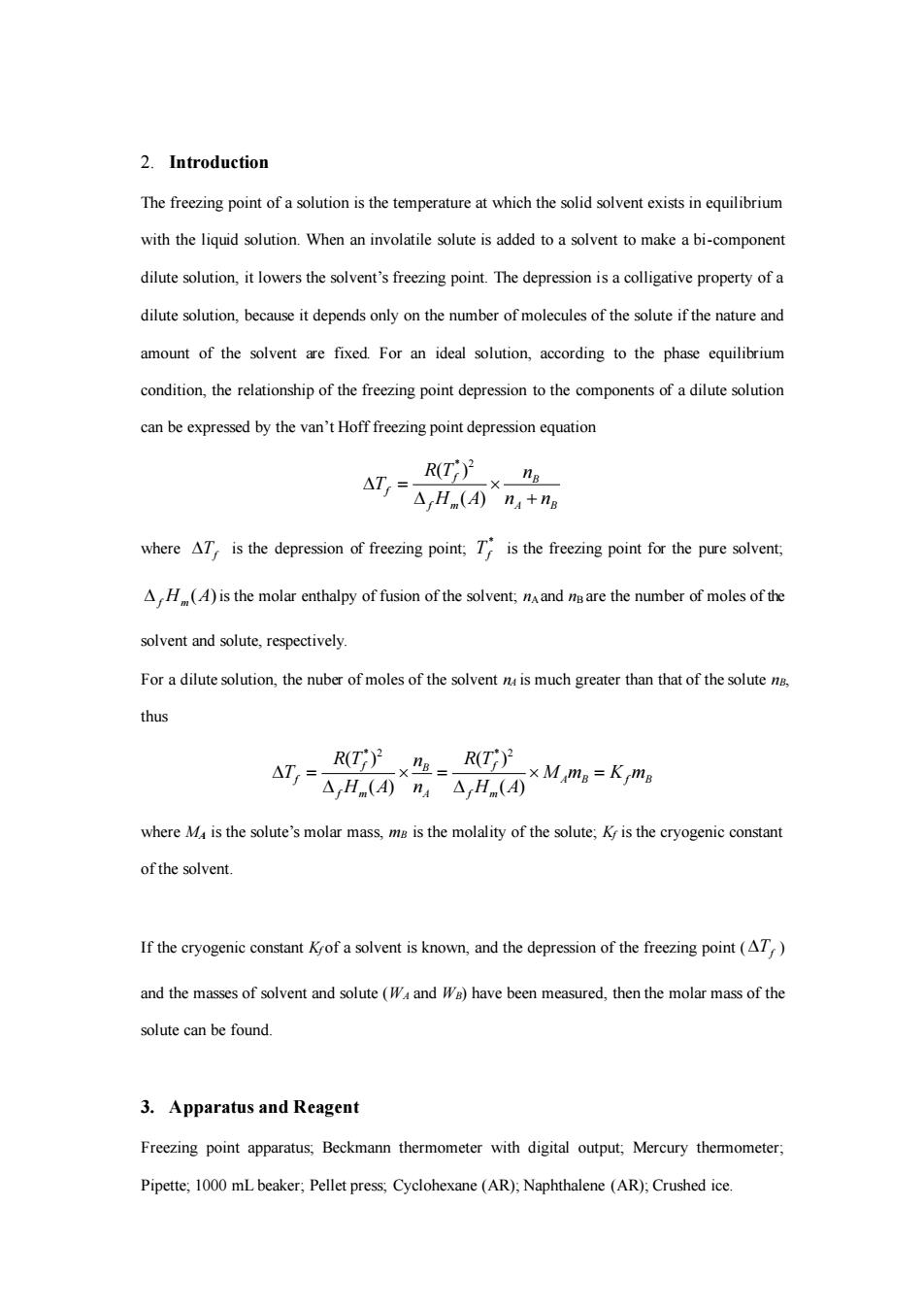
2.Introduction The freezing point of asolution is the temperature at which the soid solvent exists with the liquid solution.When an involatile solute is added to a solvent to make a bi-component dilute solution,it lowers the solvent's freezing point.The depression is a colligative property of a dilute soltion,because it depends ony on the number of molecules of the solute if the nature and amount of the solvent are fixed.For an ideal solution,according to the phase equilibrium condition.the relationship of the freezing point depression to the components of a dilute solution can be expressed by the van't Hoff freezing point depression equation R(T)2 nR △H.(A)n4+nB where AT is the depression of freezing point.T is the freezing point for the pure solvent. AH(A)is the molar enthalpy of fusion of the solvent,nand mare the number of moles of the solvent and solute,respectively. For a dilute solution,the nuber of moles of the solvent is much greater than that of the solutem thus RT》2 R(T) △,H.(丙*元4,H.(④xMm,=Km, where M is the solute's molar mass,m is the molality of the solute:K is the cryogenic constant of the solvent. If the cryogenic constant Kofa solvent is known,and the depression of the freezing point(AT) and the masses of solvent and solute (W and W)have been measured,then the molar mass of the solute can be found 3.Apparatus and Reagent Freezing point apparatus,Beckmann thermometer with digital output:Mercury themometer Pipette;1000 mL beaker,Pellet press,Cyclohexane(AR);Naphthalene (AR).Crushed ice
2. Introduction The freezing point of a solution is the temperature at which the solid solvent exists in equilibrium with the liquid solution. When an involatile solute is added to a solvent to make a bi-component dilute solution, it lowers the solvent’s freezing point. The depression is a colligative property of a dilute solution, because it depends only on the number of molecules of the solute if the nature and amount of the solvent are fixed. For an ideal solution, according to the phase equilibrium condition, the relationship of the freezing point depression to the components of a dilute solution can be expressed by the van’t Hoff freezing point depression equation A B B f m f f n n n H A R T T + = ( ) ( ) * 2 where Tf is the depression of freezing point; * Tf is the freezing point for the pure solvent; H (A) f m is the molar enthalpy of fusion of the solvent; nA and nB are the number of moles of the solvent and solute, respectively. For a dilute solution, the nuber of moles of the solvent nA is much greater than that of the solute nB, thus A B f B f m f A B f m f f M m K m H A R T n n H A R T T = = = ( ) ( ) ( ) ( ) * 2 * 2 where MA is the solute’s molar mass, mB is the molality of the solute; Kf is the cryogenic constant of the solvent. If the cryogenic constant Kf of a solvent is known, and the depression of the freezing point ( Tf ) and the masses of solvent and solute (WA and WB) have been measured, then the molar mass of the solute can be found. 3. Apparatus and Reagent Freezing point apparatus; Beckmann thermometer with digital output; Mercury thermometer; Pipette; 1000 mL beaker; Pellet press; Cyclohexane (AR); Naphthalene (AR); Crushed ice
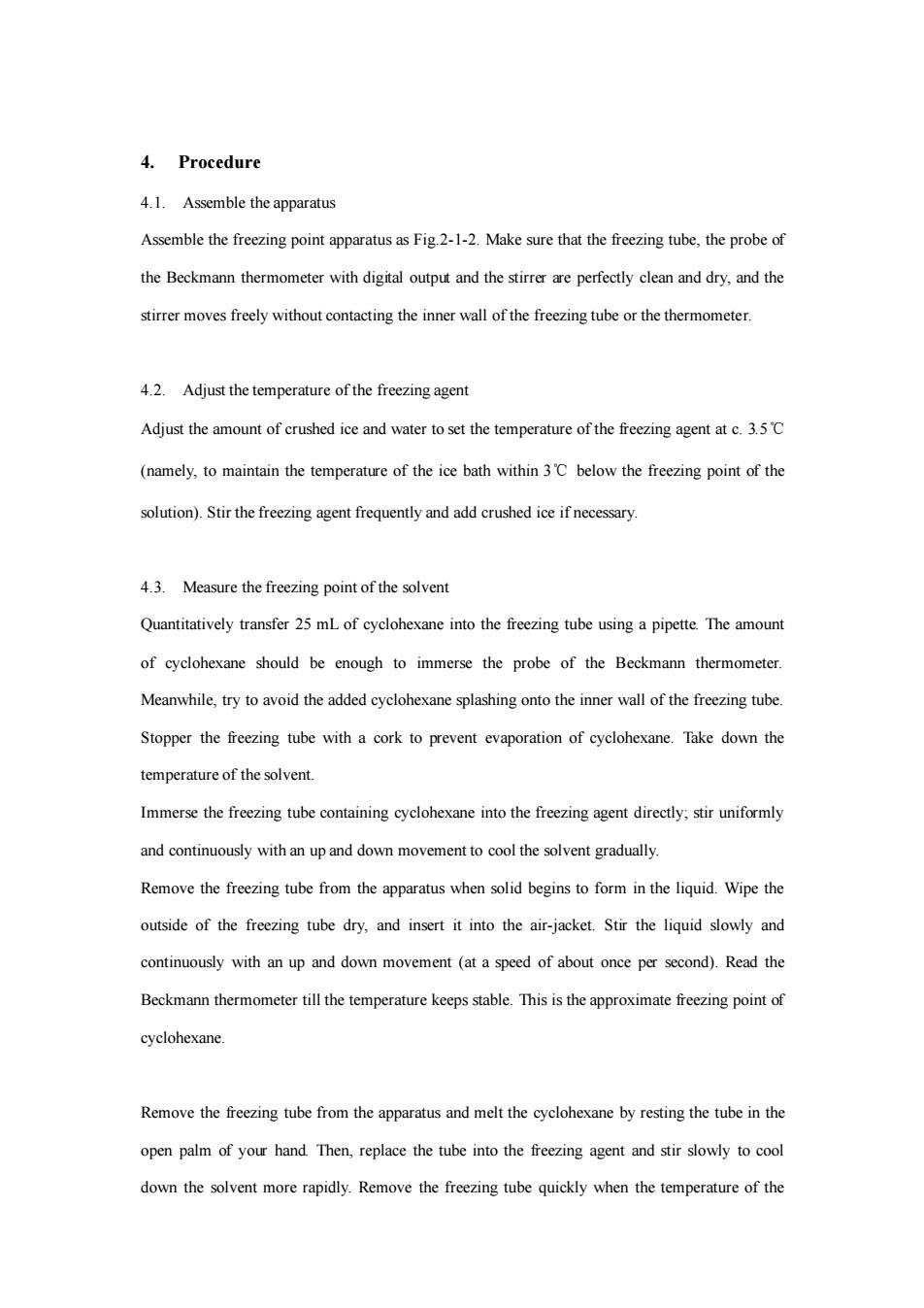
4.Procedure 4.1.Assemble the apparatus Assemble the freezing point apparatus as Fig2-1-2.Make sure that the freezing tube,the probe of the Beckmann thermometer with digital output and the stirrer are perfectly clean and dry,and the stirrer moves freely without contacting the inner wall of the freezing tube or the thermometer 4.2.Adjust the temperature of the freezing agent Adjust the amount of crushed ice and water toset the temperature of the freezing agent at c.3.5 (namely.to maintain the temperature of the ice bath within3 below the freezing point of the solution).Stir the freezing agent frequently and add crushed ice ifnecessary. 4.3.Measure the freezing point of the solvent Quantitatively transfer 25 mL of cyclohexane into the freezing tube using a pipette The amount of cyclohexane should be enough to immerse the probe of the Beckmann thermometer. Meanwhile,try to avoid the added cyclohexane splashing onto the inner wall of the freezing tube. Stopper the freezing tube with a cork to prevent evaporation of cyelohexane.Take down the temperature of the solvent. Immerse the freezing tube containing cyclohexane into the freezing agent directly:stir uniformly Remove the freezing tube from the apparatus when solid begins to form in the liquid.Wipe the outside of the freezing tube dry.and insert it into the air-jacket.Stir the liquid slowly and continuously with an up and down movement (at a speed of about once per second).Read the Beckmann thermometer till the temperature keeps stable.This is the approximate freezing point of cyclohexane Remove the freezing tube from the apparatus and melt the cyclohexane by resting the tube in the open palm of your hand Then,replace the tube into the freezing agent and stir slowly to cool down the solvent more rapidly.Remove the freezing tube quickly when the temperature of the
4. Procedure 4.1. Assemble the apparatus Assemble the freezing point apparatus as Fig.2-1-2. Make sure that the freezing tube, the probe of the Beckmann thermometer with digital output and the stirrer are perfectly clean and dry, and the stirrer moves freely without contacting the inner wall of the freezing tube or the thermometer. 4.2. Adjust the temperature of the freezing agent Adjust the amount of crushed ice and water to set the temperature of the freezing agent at c. 3.5℃ (namely, to maintain the temperature of the ice bath within 3℃ below the freezing point of the solution). Stir the freezing agent frequently and add crushed ice if necessary. 4.3. Measure the freezing point of the solvent Quantitatively transfer 25 mL of cyclohexane into the freezing tube using a pipette. The amount of cyclohexane should be enough to immerse the probe of the Beckmann thermometer. Meanwhile, try to avoid the added cyclohexane splashing onto the inner wall of the freezing tube. Stopper the freezing tube with a cork to prevent evaporation of cyclohexane. Take down the temperature of the solvent. Immerse the freezing tube containing cyclohexane into the freezing agent directly; stir uniformly and continuously with an up and down movement to cool the solvent gradually. Remove the freezing tube from the apparatus when solid begins to form in the liquid. Wipe the outside of the freezing tube dry, and insert it into the air-jacket. Stir the liquid slowly and continuously with an up and down movement (at a speed of about once per second). Read the Beckmann thermometer till the temperature keeps stable. This is the approximate freezing point of cyclohexane. Remove the freezing tube from the apparatus and melt the cyclohexane by resting the tube in the open palm of your hand. Then, replace the tube into the freezing agent and stir slowly to cool down the solvent more rapidly. Remove the freezing tube quickly when the temperature of the
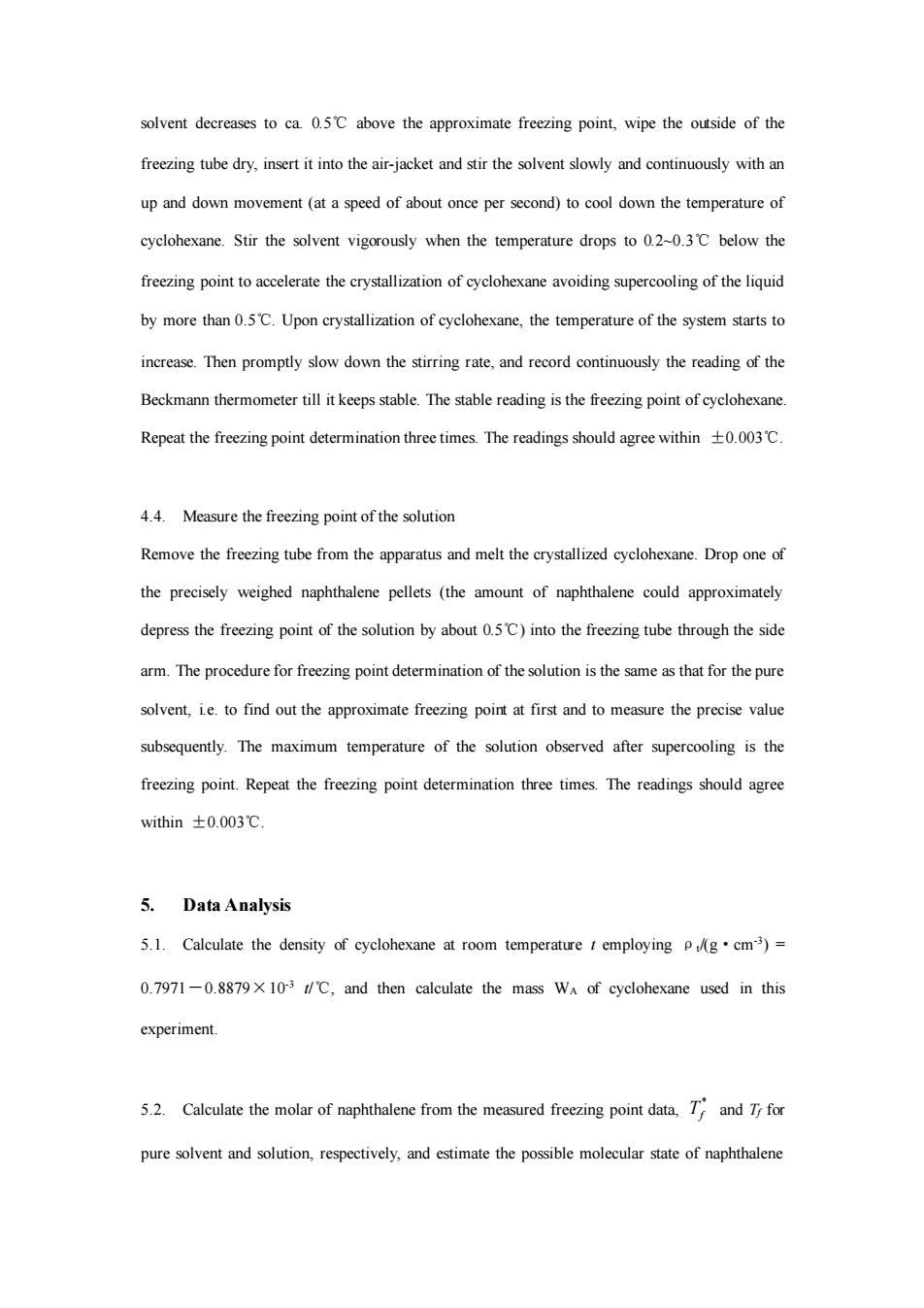
solvent decreases to ca.0.5C above the approximate freezing point,wipe the outside of the freezing tube dry,insert it into the air-jacket and stir the solvent slowly and continuously with an up and down movement(at a speed of about once per second)to cool down the temperature of cyclohexane.Stir the solvent vigorously when the temperature drops to 02~0.3C below the freezing point to accelerate the of eyelohexane avoiding supercooling of the liquid by more than 0.5C.Upon crystallization of cyclohexane,the temperature of the system starts to increase.Then promptly slow down the stirring rate,and record continuously the reading of the Beckmann thermometer till it keeps stable.The stable reading is the freezing point of cyclohexane. Repeat the freezing point determination three times.The readings should agree within03 4.4.Measure the freezing point of the solution Remove the freezing tube from the apparatus and melt the crystallized cyclohexane.Drop one of the precisely weighed naphthalene pellets (the amount of naphthalene could approximately depress the freezing point of the solution by about 05C)into the freezing tube through the side am.The for of for the pure solvent,ie.to find out the approximate freezing point at first and to measure the precise value subsequently.The maximum temperature of the solution observed after supercooling is the freezing point.Repeat the freezing point determination three times.The readings should agree within±0.003℃. 5.Data Analysis 5.1.Calculate the density of cyclohexane at room temperature t employinggcm)= 0.7971-0.8879x103/C,and then calculate the mass W of cyclohexane used in this experiment 5.2.Calculate the molar of naphthalene from the measured freezing point data,T and Tfor pure solvent and solution,respectively,and estimate the possible molecular state of naphthalene
solvent decreases to ca. 0.5℃ above the approximate freezing point, wipe the outside of the freezing tube dry, insert it into the air-jacket and stir the solvent slowly and continuously with an up and down movement (at a speed of about once per second) to cool down the temperature of cyclohexane. Stir the solvent vigorously when the temperature drops to 0.2~0.3℃ below the freezing point to accelerate the crystallization of cyclohexane avoiding supercooling of the liquid by more than 0.5℃. Upon crystallization of cyclohexane, the temperature of the system starts to increase. Then promptly slow down the stirring rate, and record continuously the reading of the Beckmann thermometer till it keeps stable. The stable reading is the freezing point of cyclohexane. Repeat the freezing point determination three times. The readings should agree within ±0.003℃. 4.4. Measure the freezing point of the solution Remove the freezing tube from the apparatus and melt the crystallized cyclohexane. Drop one of the precisely weighed naphthalene pellets (the amount of naphthalene could approximately depress the freezing point of the solution by about 0.5℃) into the freezing tube through the side arm. The procedure for freezing point determination of the solution is the same as that for the pure solvent, i.e. to find out the approximate freezing point at first and to measure the precise value subsequently. The maximum temperature of the solution observed after supercooling is the freezing point. Repeat the freezing point determination three times. The readings should agree within ±0.003℃. 5. Data Analysis 5.1. Calculate the density of cyclohexane at room temperature t employing ρt/(g·cm-3 ) = 0.7971-0.8879×10-3 t/℃, and then calculate the mass WA of cyclohexane used in this experiment. 5.2. Calculate the molar of naphthalene from the measured freezing point data, * Tf and Tf for pure solvent and solution, respectively, and estimate the possible molecular state of naphthalene